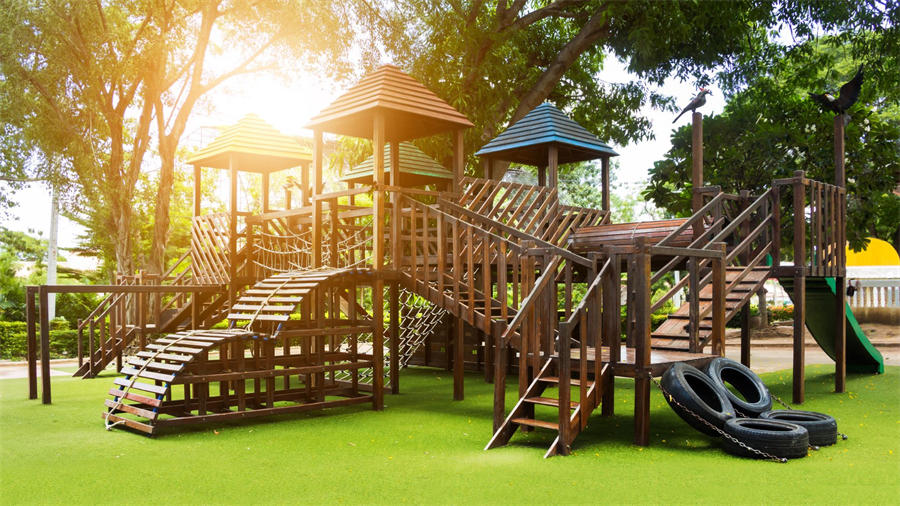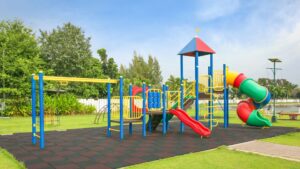Les aires de jeux en bois symbolisaient autrefois les étés de l'enfance et les plaisirs du voisinage. Datant du milieu du XIXe siècle, les structures en bois ont dominé jusqu'à ce que l'acier, le plastique et les matériaux composites prennent de l'importance. Aujourd'hui, cependant, les aires de jeux en bois disparaissent rapidement des parcs du monde entier. Pourquoi les collectivités abandonnent-elles progressivement ces icônes nostalgiques au profit d'alternatives modernes ?
Dans ce guide complet, nous explorons les six raisons principales qui expliquent la la disparition des aires de jeux en boisIls examinent les coûts cachés de l'entretien, évaluent l'évolution des normes de sécurité et montrent comment les matériaux contemporains - le plastique, le vinyle et l'acier - permettent de créer des environnements de jeu plus vivants, plus accessibles et plus durables.

1. Coûts d'entretien élevés
1.1 Réparations et remplacements fréquents
- Décroissance structurelle : Le bois se dégrade naturellement lorsqu'il est exposé à l'humidité et à la lumière du soleil. Les poteaux de soutien, les terrasses et les garde-corps doivent souvent être remplacés tous les 8 à 12 ans.
- Coloration et scellement de routine : Pour éviter la pourriture et les dégâts causés par les insectes, les bois des aires de jeux doivent être teintés ou scellés chaque année, ce qui représente des coûts de main-d'œuvre et de matériel qui pèsent sur les budgets des municipalités et des écoles.
1.2 Incidences budgétaires
- Soins à forte intensité de main-d'œuvre : Les équipes des parcs doivent consacrer beaucoup de temps au ponçage des planches fendues, au resserrement des fixations desserrées et à l'application de revêtements protecteurs.
- Dépenses imprévisibles : Les intempéries (tempêtes, inondations) peuvent accélérer la détérioration et entraîner des factures de réparation soudaines et imprévues.
Étude de cas : Une ville de taille moyenne a estimé l'entretien annuel des aires de jeux en bois à $15 000, contre moins de $5 000 pour les installations en matériaux composites après la première décennie.

2. Augmentation des risques pour la sécurité
2.1 Échardes et bords tranchants
- Avec l'usure du bois, les fibres de surface se détachent et provoquent des échardes douloureuses. Les enfants qui grimpent et glissent risquent des coupures et des perforations.
2.2 Risques de trébuchement et de coincement
- Rétrécissement et déformation : Les planches peuvent se déformer, créant des surfaces inégales et des risques de trébuchement.
- Lacunes et fissures : Les articulations s'élargissent avec le temps, ce qui peut entraîner le coincement des doigts ou des petits pieds.
2.3 Germes, moisissures et mildiou
- Préoccupations sanitaires : Les zones humides et ombragées des structures en bois favorisent la croissance des moisissures, ce qui présente des risques d'irritation des voies respiratoires et de la peau.
- Pathogen Harbor : Le bois poreux peut absorber les liquides renversés, les restes de pique-nique et les déjections animales, ce qui nécessite un nettoyage intensif pour maintenir l'hygiène.
Mise à jour des normes de sécurité : Les dernières directives ASTM F1487 relatives aux aires de jeux recommandent l'utilisation de surfaces non poreuses dans toutes les zones de contact afin de réduire les risques d'infection.

3. Durée de vie courte par rapport aux matériaux modernes
3.1 Dégradation naturelle
- Pourriture et décomposition : Même le bois traité sous pression a une durée de vie de 10 à 15 ans à l'extérieur.
- Infestation d'insectes : Les termites, les fourmis charpentières et les coléoptères xylophages peuvent compromettre l'intégrité de la structure.
3.2 Dommages causés par les intempéries
- Exposition aux UV : La lumière du soleil décompose la lignine du bois, ce qui entraîne un grisonnement et un fendillement de la surface.
- Gonflement de l'eau : La pluie et l'humidité provoquent des cycles de dilatation et de contraction du panneau, ce qui accélère le fendillement.
3.3 Durabilité comparée
| Matériau | Durée de vie typique | Cycle de maintenance |
|---|---|---|
| Bois | 10-15 ans | Coloration annuelle |
| Acier/Aluminium | 30 ans et plus | Peinture occasionnelle |
| Plastique/Composite | 20-25 ans | Faible, rinçage et nettoyage |
Les plastiques modernes, les alliages métalliques et les bois composites résistent à la pourriture, à la rouille, aux insectes et aux dommages causés par les UV, et durent souvent deux à trois fois plus longtemps avec un entretien minimal.

4. Flexibilité de conception et attrait esthétique limités
4.1 Monochrome et monolithique
- Les aires de jeux en bois ont tendance à utiliser des tons de bois naturels et des formes simples. Les couleurs personnalisées, les thèmes vifs et les formes uniques sont difficiles, voire impossibles à réaliser.
4.2 Modernisation de la marque et de l'engagement
- Zones de jeu à thème : Les parcs contemporains comportent des toboggans colorés, des filets d'escalade et des panneaux interactifs alignés sur la culture locale, les mascottes ou les thèmes éducatifs, ce qui n'est pas pratique dans une construction entièrement en bois.
- Inclusion et accessibilité : Des rampes vibrantes, des formes moulées et des panneaux texturés permettent d'intégrer des jeux sensoriels et accessibles aux fauteuils roulants, des conceptions mieux exécutées en plastique ou en métal.
Alerte à la tendance : Les parcs intègrent désormais des revêtements en caoutchouc multicolores, des structures éclairées par des LED et des tubes d'acier courbés - des caractéristiques incompatibles avec le bois traditionnel.

5. Évolution des normes de sécurité et préoccupations en matière de responsabilité
5.1 Des réglementations plus strictes
- Des agences telles que la Consumer Product Safety Commission (CPSC) et l'ASTM ont renforcé les directives relatives à l'atténuation des impacts de surface, à la stabilité structurelle et à la toxicité des matériaux.
- Surfaces absorbant les chocs : La norme ASTM F1292 impose de tester les matériaux de revêtement des aires de jeux ; les terrasses en bois ne peuvent à elles seules répondre à ces exigences en matière d'absorption des chocs.
5.2 Responsabilité accrue
- Risques d'accident : Les défaillances des équipements liées aux échardes, aux points de pincement et à la pourriture augmentent les risques de blessures et de poursuites judiciaires.
- Frais d'assurance : Les polices d'assurance des municipalités et des districts scolaires prévoient des primes plus élevées pour les aires de jeux en bois en raison du risque élevé.
Encouragement à la responsabilité : De nombreuses juridictions exigent désormais des audits annuels de sécurité réalisés par des tiers, car les structures en bois s'effondrent souvent en raison d'un pourrissement non détecté.

6. Émergence de matériaux durables et à faible impact
6.1 Bois de construction en plastique recyclé
- Fabriqué à partir de plastiques post-consommation (bidons de lait, sacs d'épicerie), il imite le grain du bois sans les inconvénients de la matière organique. Imperméable à la pourriture, aux insectes et aux moisissures.
6.2 Acier et alliages d'aluminium
- L'acier galvanisé et l'aluminium inoxydable soutiennent des conceptions structurelles audacieuses. Le revêtement en poudre ajoute des couleurs vives et résistantes à la décoloration.
6.3 Produits de remplacement du bois d'ingénierie
- Bois composite : Mélange de fibres de bois et de plastiques recyclés pour un équilibre entre texture et durabilité - recyclable et facile d'entretien.
- Bambou: Dans certains climats, le bambou stratifié offre une résistance naturelle et une régénération plus rapide que les bois durs.

7. Avantages des matériaux modernes pour aires de jeux
| Bénéfice | Bois | Matériaux modernes |
|---|---|---|
| Durabilité | Faible | Haut |
| Coût de la maintenance | Haut | Faible |
| Sécurité (échardes/décroissance) | Pauvre | Excellent |
| Flexibilité de la conception | Limitée | Très large |
| Impact sur l'environnement (à long terme) | Modéré (récolté) | Contenu recyclé, moins de déchets en décharge |
8. Stratégies de transition pour les parcs
8.1 Remplacement progressif
- Améliorations section par section : Donner la priorité aux zones à forte utilisation et à haut risque pour le remplacement initial.
- Aires de jeux hybrides : Combinez des éléments en bois existants avec de nouvelles sections métalliques ou composites pour allier nostalgie et innovation.
8.2 Engagement communautaire
- Ateliers publics : Expliquer aux résidents les économies de maintenance, les gains de sécurité et les nouvelles possibilités de conception.
- Installations pilotes : Présenter des modules de jeu modernes à petite échelle afin de susciter l'adhésion avant la transformation complète du parc.
8.3 Financement et subventions
- Subventions nationales et fédérales : Obtenir des subventions pour l'amélioration des aires de jeux en fonction de la sécurité et de l'accessibilité.
- Parrainage d'entreprise : Établissez des partenariats avec des entreprises locales pour obtenir des droits d'appellation, des fonds de contrepartie ou des dons en nature.

9. Exemples concrets
9.1 Renouvellement des parcs de la ville de Springfield
- Enlèvement d'un jeu en bois vieux de 20 ans ; installation de structures en plastique composite avec balançoires intégrées, filets d'escalade et revêtement en caoutchouc.
- Résultat : Les coûts d'entretien ont baissé de 70%, les blessures signalées ont diminué de 60% et la fréquentation du parc a doublé en l'espace de deux ans.
9.2 Terrain de jeux communautaire de Riverside
- Suppression progressive des terrasses en bois au profit d'une ossature en aluminium et d'un revêtement en plastique recyclé. Ajout de toboggans thématiques d'inspiration maritime et de panneaux sensoriels.
- Résultat : A remporté le prix de l'État pour le "parc le plus inclusif", a attiré de nouveaux événements et a augmenté le nombre de parrainages d'entreprises locales.

10. Conclusion
Les aires de jeux en bois, qui constituaient autrefois le cœur des parcs communautaires, disparaissent progressivement à mesure que les normes de sécurité évoluent, que les charges d'entretien montent en flèche et que des matériaux innovants ouvrent de nouveaux horizons en matière de conception. Si la nostalgie des aires de jeux en bois perdure, les avantages pragmatiques de l'acier, du plastique et des matériaux composites - durabilité, faible entretien, esthétique vibrante et sécurité supérieure - sont incontestables.
Les collectivités et les administrateurs de parcs peuvent gérer cette transition en procédant à des améliorations progressives, en engageant un dialogue public et en adoptant des stratégies de financement judicieuses. Le résultat : des espaces de jeu modernes qui honorent la joie des traditions des aires de jeu tout en offrant des expériences plus sûres, plus durables et plus inclusives pour les enfants de tous niveaux.
Prêt à moderniser l'aire de jeux de votre parc ?
Découvrez notre sélection de structures de jeux à faible entretien et à sécurité certifiée, fabriquées à partir de plastiques recyclés, de métaux durables et de matériaux composites. Contact SPIKE Amusement pour des consultations sur la conception personnalisée, une aide à la rédaction de demandes de subventions et des services d'installation clés en main.
Construisons ensemble l'avenir du jeu !




